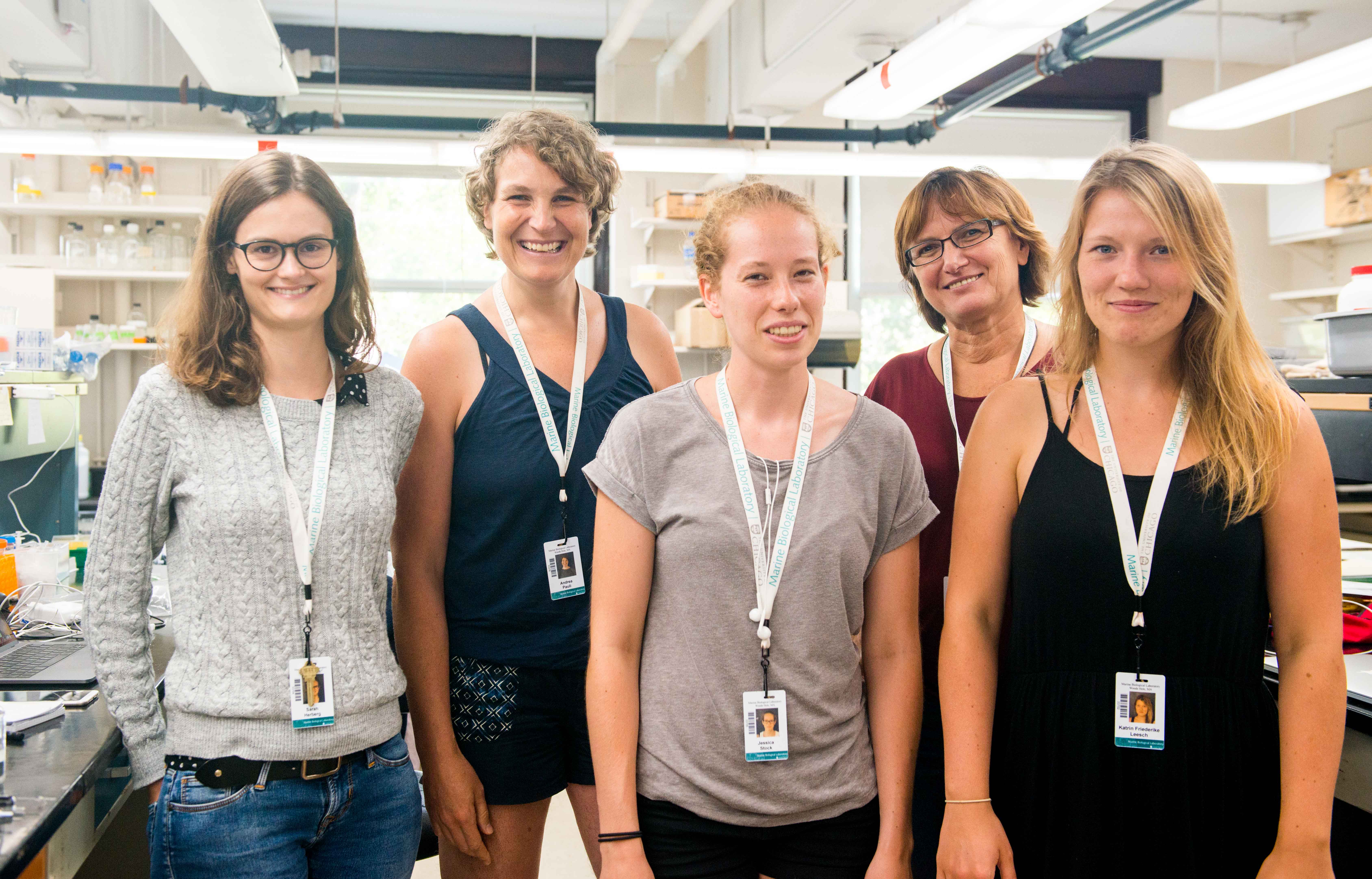Whitman Fellow Andrea Pauli Christens “Bouncer,” Gatekeeper of the Egg

“I think Bouncer is absolutely amazing,” Andrea Pauli says, referring to a very short but powerful protein her lab discovered that's required for sperm to penetrate an egg during zebrafish fertilization. Not only that, Bouncer blocks entry to the egg by different species of sperm – hence the gatekeeper-at-a-nightclub name they chose for this potent fertilization factor.
Bouncer’s discovery was reported in Science on Sept. 7, shortly after Pauli wrapped up her summer research in the MBL Whitman Center and returned to her lab at the Research Institute of Molecular Pathology (IMP) in Vienna, Austria, where Bouncer’s function was identified.
“I honestly didn’t believe that this one little protein, Bouncer, would allow the correct species of sperm to enter while keeping the wrong ones out,” Pauli says. “I thought it would be much more likely a combination of different factors. But our results reveal a key role for Bouncer as the gatekeeper of the oocyte (egg).”
This is a significant advance for the field of fertilization research, which has been conducted at the MBL for more than a century. Surprisingly, very few factors have been identified that are essential for egg-sperm recognition or species-specific fertilization since Oscar Hertwig first described fertilization in sea urchins in 1876.
Pauli’s lab has determined that Bouncer sits on the egg's surface in fish while in mammals, curiously, Bouncer’s homolog (SPACA4) sits on the sperm's surface. Whether SPACA4 is required for sperm to enter the egg in mammals is still unclear.
To follow up on the exciting Bouncer discovery and expand other ongoing research areas, Pauli brought four of her lab members to the MBL last summer, where she was a Whitman Fellow, and asked each of them to define and pursue a research project that “would be better to do in Woods Hole than in Vienna,” she says.
For instance, to glean more clues about Bouncer’s mechanism of action, they took advantage of the many species maintained by the MBL Marine Resources Center and MBL’s strengths in imaging. One idea was to collect eggs and sperm from various fish species to test for their cross-species fertilization ability and to profile their Bouncer sequences – a project that turned out to be much harder than anticipated. They also piloted imaging studies to look at the egg’s surface and at Bouncer dynamics, to ultimately learn how Bouncer mediates sperm-egg interaction.
Pauli also drew upon MBL expertise to find out what can’t be easily done. Prior to Bouncer, Pauli had discovered another short protein (Toddler) that is essential for cell migration during the gastrulation phase of embryonic development.
 Members of the Pauli lab from IMP Vienna in the MBL Whitman Center. From left: Sarah Herberg (first author on the Bouncer Science paper); Andrea Pauli (IMP Group Leader); Jessica Stock (PhD student); Kasia Hammar of MBL; and Friederike Leesch (PhD student). Not pictured: Krista Gert, Pauli lab PhD student who also came to MBL. Credit: Megan Costello
Members of the Pauli lab from IMP Vienna in the MBL Whitman Center. From left: Sarah Herberg (first author on the Bouncer Science paper); Andrea Pauli (IMP Group Leader); Jessica Stock (PhD student); Kasia Hammar of MBL; and Friederike Leesch (PhD student). Not pictured: Krista Gert, Pauli lab PhD student who also came to MBL. Credit: Megan Costello“In Vienna, we are trying to figure out how Toddler regulates cell migration in zebrafish. So at MBL, we wanted to expand our studies and use live-cell imaging to see how gastrulation happens in several other species,” she says.
“We thought live imaging just hadn’t been done, because reports about cell movement during gastrulation in classical model systems, like the sea urchin, are very scarce in the scientific literature. But when we got to MBL, several people from the fertilization field told us, ‘Oh, yeah. We've been trying to do that for 20 years but because the embryos spin so fast, no one has been able to fix them [for imaging].’ It’s super-hard to do. And that was something we just didn't know!”
The MBL “was ideal, like a playground,” Pauli says, for another project they pursued: collecting eggs, sperm, and body tissue from as many species as possible so they can genetically compare the germline-to-embryo transition across species. “We had a whole box of samples – squid, sea urchins, sea stars, etc. -- to ship back to Vienna,” she says.
But while she was happy with the data they collected, interacting with the scientifically diverse MBL community was of even greater value. “The MBL is a great place to think outside of the box, get new ideas, talk to people about things you would normally never hear about, interact with people you would normally never come across,” Pauli says.
“I learned about so much interesting biology and different animal systems at MBL. I kept saying, ‘Oh wow! I’ve never even heard of this! All these organisms - what could one do here?!’ It’s really cool.”
###
The Pauli lab wishes to acknowledge the collaborative scientific community at MBL that offered help, advice and reagents throughout their stay in the Whitman Center. Special thanks are extended to: Pierre Gönczy (Whitman Fellow, Swiss Federal Institute of Technology, Lausanne), Kasia Hammar (MBL), Carrie Albertin (MBL), Benjamin Kaupp (Whitman Scientist, Research Center Caesar, Bonn), Mark Terasaki (Whitman Scientist, University of Connecticut Health Center), Edgar Gomes (Whitman Fellow, iMM Lisbon), Daniel Gibson (Whitman Scientist, Worcester Polytechnic Institute), Chris Sansam (Whitman Fellow, Oklahoma Medical Research Foundation), Amy Herbert (Grass Fellow, Washington University in St. Louis), Tessa Montague (Grass Fellow, Harvard University), Lisa Abott (MBL), the staff from the MBL Marine Resources Center and Zebrafish Facility, and John Allen (Nikon).
Homepage photo: Andrea Pauli working with zebrafish. Credit: IMP/Lukas Beck
